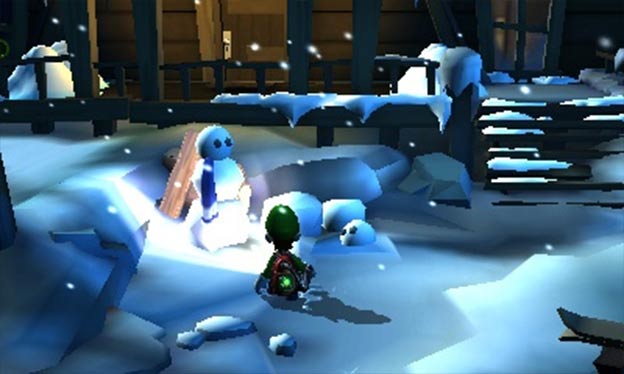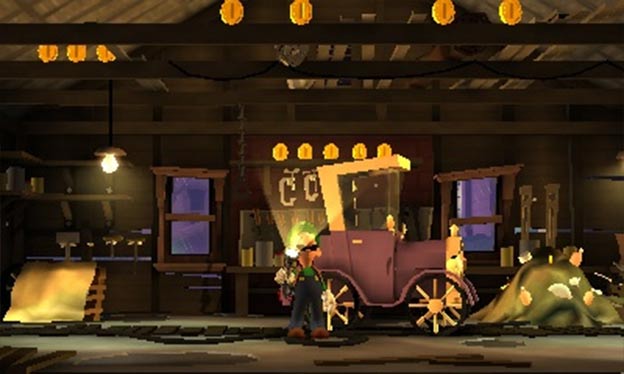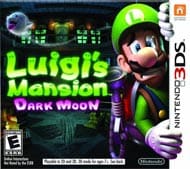Adventures In Ghostbusting
Luigi has always been the saner half of the Mario Bros. While Mario rushes headlong into danger and flings himself over lava pits with abandon, Luigi is a fair bit more reluctant about the whole “saving the world” endeavor. A coward he may be, but how do you think you’d react when facing down a giant slavering carnivorous plant?
Sometimes even the second fiddle gets a solo, though, and Luigi’s Mansion: Dark Moon is Vancouver developer Next Level Games’ chance to take the green guy for a spin. The company has taken the original Luigi’s Mansion formula from the GameCube era and turned it into something far more special. An adventure game that breaks the mold of the genre, it’s both a game and an experience .

The premise is simple: Professor E. Gadd calls Luigi in because the normally friendly ghosts in a haunted valley have gone hostile. Luigi must venture through five spooky buildings and track down fragments of the Dark Moon, which will calm them down again when it’s reassembled. Armed with his trusty Poltergust vacuum, Luigi will have to scour every corner of the mansions to complete his quest.
Luigi’s Mansion: Dark Moon is first and foremost an audiovisual experience. The development team’s love for Nintendo’s style and characters is clear, and the game boasts some of the best graphics yet seen on the 3DS. The five different mansions have unique visual styles and interesting themes that I won’t spoil here. Suffice it to say that the final mansion is the most fun and interesting of all, well worth the journey there.
The animations and visual effects that the player will encounter are top-notch, which is important because of how closely they’re woven into the gameplay. The only interface is a map and quest list on the bottom screen. Instead of interacting with the telegraphed “hot spots” found in many adventure games, the player must pay close attention to the visual cues in the environment in order to solve puzzles and defeat ghosts.

Luigi has three tools at his disposal: the Poltergust, which not only sucks up ghosts and treasure, but is used to push and pull items in the environment; a strobe light that stuns ghosts and activates machinery; and a dark light that reveals hidden items. These simple tools are put to a multitude of uses over the course of the game, and players need to pay close attention to their surroundings in order to figure out new uses for them.
Fortunately, the excellent visual and animation work makes this a treat. Slightly upturned carpet corners or subtly flapping fabric denote items that can be pulled with the Poltergust. Closed flower buds can be flashed with the strobe light, opening and revealing treasure. Empty locations with suspicious shadows suggest that the dark light should be employed. The game makes impressive use of mirrors and optical illusions in its puzzles as well, creating situations that feel satisfying to suss out. Solving puzzles almost never feels like a pixel hunt because these visual cues are so well-done.
The character animations make the game far more charming than scary. Luigi may be a reluctant hero with a tendency to cower in terror, but his fist pumps and victory jigs when he does something successfully make him quite likeable. The ghosts are bursting with personality, from the mischievous greenies to the sinister possessor spirits to the adorable Polterpup who just wants somebody to play with.

Excellent sound design backs up the game’s visual punch. Luigi has a tendency to hum along with the background music if left idle for too long, and he’s been given a fair number of little spoken clips that help to establish him as a character. The atmospheric sounds both establish mood and assist in puzzle solving, and the ghosts spend plenty of time taunting Luigi with spectral laughter. The game could have used more diversity in background music, but that’s really the only complaint that can be made about its audiovisuals.
Each mansion plays host to a number of short missions, which makes the game portable-friendly. These missions have various goals, in which Luigi must attempt to traverse the mansion to reach a particular objective, hunt down a dangerous ghost, track the Polterpup after it steals an important item, etc. Sometimes Luigi must retread familiar territory on multiple missions, but there are usually enough changes to that territory to keep things interesting. The boss fights, found in the last mission of each mansion, are particularly impressive. They require Luigi to think on his feet and use the environment to his advantage in order to defeat the game’s most intelligent poltergeists.
When it comes down to catching ghosts, Luigi’s Mansion: Dark Moon introduces a mild action element. Different ghosts have different behaviors, but in essence they all must be stunned with the strobe light, then sucked in with the Poltergust. The player must pull in the opposite direction of the ghost with the left stick while holding down the Poltergust’s “suck” button. Of course, any ghosts in the area that haven’t been stunned will make life difficult for Luigi, who must attempt to avoid them while wrangling his stunned ghost or dodge attacks with the B button. The controls are generally intuitive and easy to use, though gamers may find their hands cramping up after a bit, especially in multiplayer mode.
Collecting treasure while exploring the mansion allows Luigi to upgrade his tools, which is particularly important in the case of the Poltergust. The fully upgraded Poltergust is much faster at sucking up ghosts than the basic version, which makes ghost hunting less frustrating and easier on the hands. Players having trouble with a particular boss fight may wish to replay previous missions for a while, uncovering previously missed treasure and collecting enough money to upgrade the Poltergust in a way that makes the battle easier to win.
A few collectables give the game added play value. There are hidden gems in all the mansions, and collecting an entire set for a mansion is a challenging task. There is also a hidden Boo on each non-boss level, and finding all the Boos in a particular mansion opens up a bonus mission. The developers had a great deal of fun giving each Boo a punny name and silly catch phrase, which makes finding and defeating them enjoyable.

The one system that is imperfectly integrated into the experience as a whole is the hit point system. Luigi has a hundred hit points (measured in hearts), but everything does damage in fives and tens, so twenty hit points would have worked just as well. He can regain hearts by searching containers throughout the mansions, and occasionally defeated ghosts drop hearts as well. If his hit points drop to zero, he gets knocked out, loses all progress, and has to start the mission over again. Since the player is most likely to die from a big fight near the end of a mission, this can be very frustrating.
Luigi can be automatically revived by the Polterpup once per mission if he finds a golden ghostly dog bone during his travels. The game claims that the dog bone is more likely to show up in a container the more treasure a player has collected. The big problem with this system is that golden bones are the least likely to be found during each mansion’s boss fight mission, the one time the player is most likely to need one. Although the game is easy enough that most players won’t die very often, the strangely punishing death mechanic goes against the general feel of the game and is a real downer when it’s encountered, especially if the player has collected a bunch of treasure and gems during a level only to lose them all via knockout. Overall this is a minor quibble—it’s just a bit obnoxious when you end up on the wrong side of it.
One place where death comes early and often is in the game’s multiplayer mode, in which one to four players take on a multi-level Scarescraper. Players can join up locally or online, choosing between several timed co-op challenges such as hunting ghosts or tracking down Polterpups. Players ascend the tower, taking on increasingly difficult challenges until they must defeat a boss fight at the top.
The game generously allows full use of the multiplayer mode via Download Play, so you can even play (locally) with friends who don’t own the game. The challenges are fairly simple but fun, with the exception of the “rush” challenge, which isn’t as interesting as the modes that involve ghost hunting. Players can choose between several difficulty levels, which is especially useful for playing solo or with just one other player. The challenges are tuned for four players, so smaller groups will probably want to play on normal.
Luigi’s Mansion: Dark Moon is a breath of fresh air during this crazy month of AAA game releases. It’s a gently paced, genre-defying adventure that oozes creative design and is a treat for the eyes and ears. Its developers did an excellent job nailing Nintendo’s charm, and the game will appeal to fans of the company and anybody who enjoys exploration in games. Nintendo has been releasing a string of quality games on the 3DS lately, and this one is just another reason to get your hands on the little portable.
RATING OUT OF 5 RATING DESCRIPTION 4.5 Graphics
One of the best-looking games on the 3DS, both in terms of graphics and animation. 3.5 Control
Easy to control, though heavy use of held-down shoulder buttons can be hard on the hands. 4.0 Music / Sound FX / Voice Acting
The sound effects are excellent and make up for there being only one main musical theme. 3.5 Play Value
Though the main game isn’t incredibly long, there are collectables, bonus levels to unlock, and multiplayer modes. 3.9 Overall Rating – Good
Not an average. See Rating legend below for a final score breakdown.
| Review Rating Legend | |||
|---|---|---|---|
| 0.1 – 1.9 = Avoid | 2.5 – 2.9 = Average | 3.5 – 3.9 = Good | 4.5 – 4.9 = Must Buy |
| 2.0 – 2.4 = Poor | 3.0 – 3.4 = Fair | 4.0 – 4.4 = Great | 5.0 = The Best |
Game Features:
